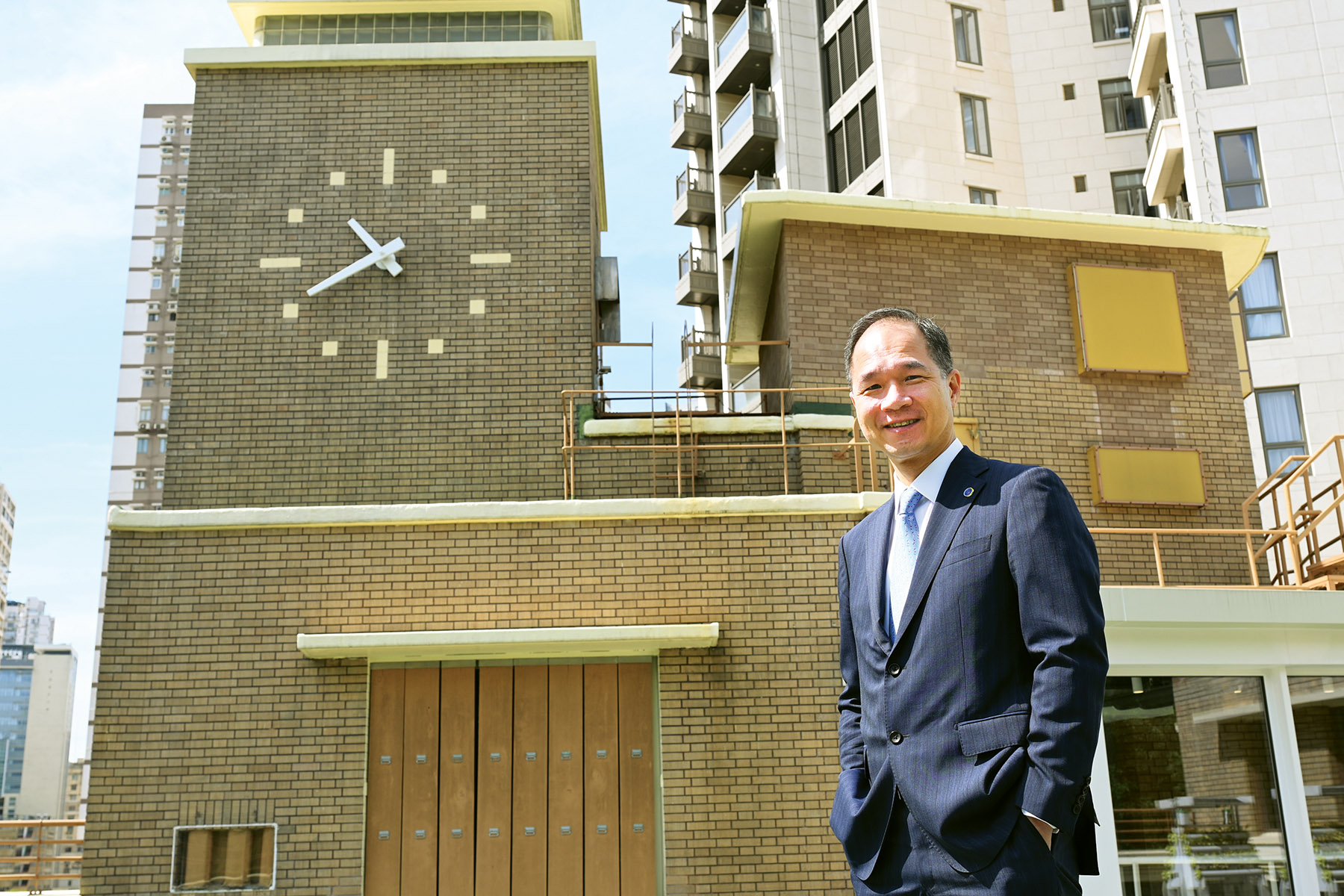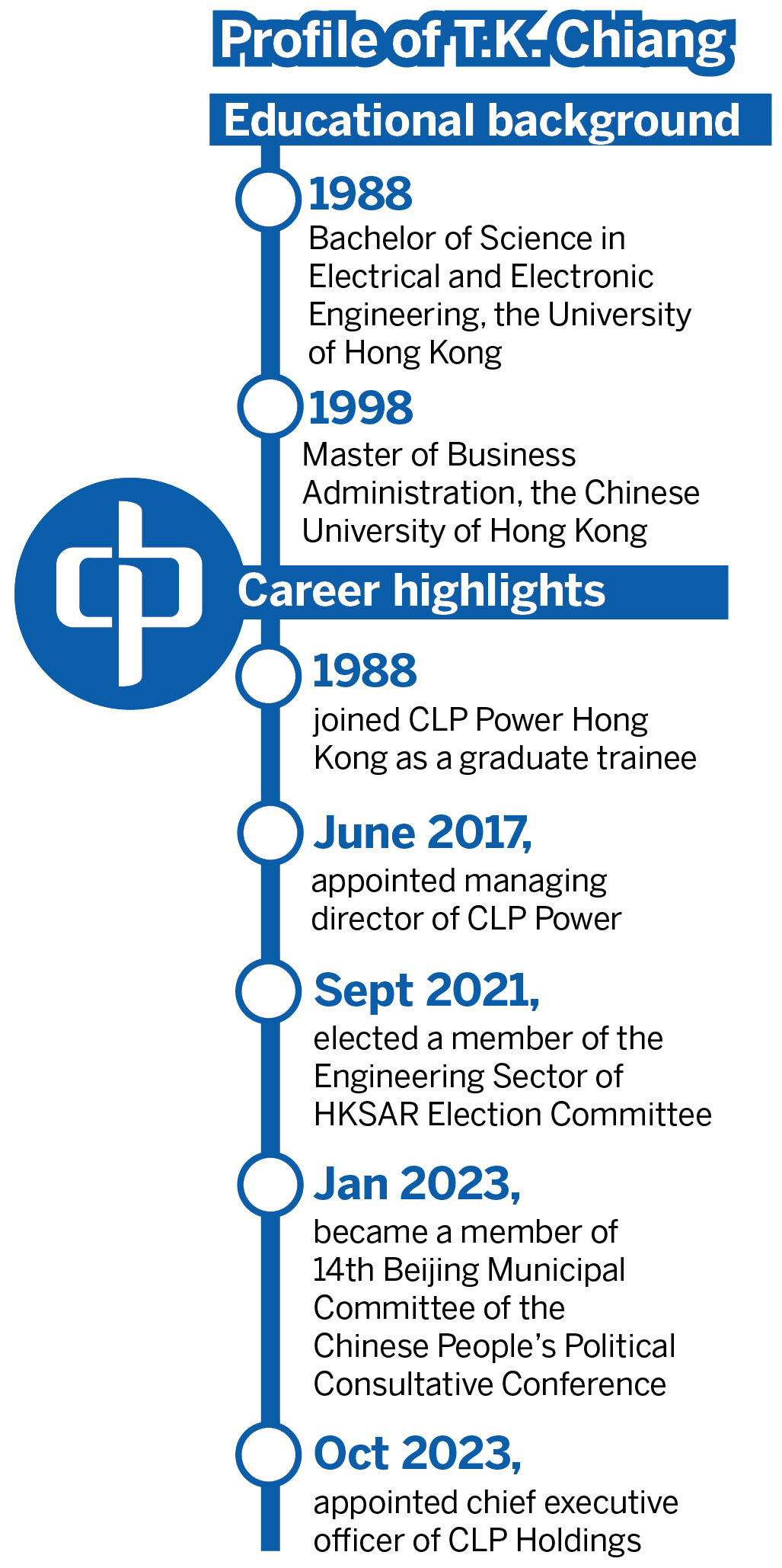T.K. Chiang leads the city’s power giant to embrace digital advancements and sustainable practices, aiming at meeting ambitious green goals

CLP Holdings Ltd Chief Executive Officer T.K. Chiang started his recent media interview by inviting journalists to walk up the winding period staircase to the rooftop of the CLP clock tower, one of Hong Kong’s most iconic buildings, situated in Ho Man Tin, Kowloon.
Although the Grade 1 historic building was once CLP’s head office and Chiang has been with the city’s biggest electricity company for more than 35 years, he only worked there for about six years.
This is partly because the clock tower, which was completed in 1940 as part of a bigger office complex, ended its role as the company’s headquarters in 2012. The building has since been revitalized and now houses CLP Pulse, a museum showcasing the development of the electricity industry.
But the main reason is that Chiang, who joined CLP as a graduate trainee in 1988, was busy at other CLP premises as he learned the ropes of the technically demanding electricity industry and familiarized himself with the company’s operations in a variety of engineering and management positions.
A year after stepping into his current role at the helm of CLP, which has expanded to other Asia-Pacific markets including the Chinese mainland, Australia and India, Chiang said he remains motivated by a drive for continuous improvement. “My motto is to make today better than yesterday,” Chiang said.
READ MORE: CLP powers up HK’s carbon neutrality target
Chiang’s personal ethos resonates with CLP’s core values of “care, excellence, and responsibility”, which he said are deeply ingrained into decision-making throughout the business, supporting the company’s declared aim to Power Brighter Tomorrows. He said these core values will continue to guide CLP as the company navigates the opportunities and challenges of decarbonization and digitalization in the energy sector, with the business focused on raising the capabilities of the workforce to meet fast-evolving market needs.
Recalling the start of his career with CLP, Chiang said he remains grateful for the opportunity to join the company’s flagship graduate trainee program, which enabled him to rotate across different business units along the energy value chain, gaining a broad gamut of engineering and management skills, as well as a comprehensive understanding of the business.
The experience made Chiang appreciative of CLP’s Cares for People culture and its longstanding commitment to support employees’ growth and development. In addition to its programs for graduates and students, CLP offers employees comprehensive training ranging from engineering, business skills to digital technologies, as well as leadership programs targeted at high-potential staff.
To further strengthen its workforce capabilities, CLP is also stepping up talent recruitment efforts outside Hong Kong. This year, eight out of 33 trainee program participants were graduates from Chinese mainland universities. In addition, CLP is expanding its campus recruitment for the upcoming cohort by holding information sessions at Tsinghua University, Shanghai Jiao Tong University, South China University of Technology, and four other mainland insitutions. At the same time, it is bolstering efforts to recruit graduates from universities in the United Kingdom, Singapore, Canada, and Australia.
Recruiting overseas talent has also been a major focus of the Hong Kong Special Administrative Region government, with Chief Executive John Lee Ka-chiu announcing a plan in last month’s Policy Address to set up a committee on education, technology, and talents to promote the city as an international hub for high-caliber talents.
As Chiang continues his efforts to deliver sustainable growth for CLP’s business, he said that teamwork is extremely important, with the company continuing to enhance measures to enable employees to collaborate more productively.
CLP’s effective response to Super Typhoon Mangkhut in September 2018, when Chiang was managing director of CLP Power Hong Kong Ltd, served as an example of the company’s capacity for collaboration.
“Many colleagues volunteered to keep working despite the severe weather conditions,” Chiang recalled. Mangkhut became the most powerful typhoon to hit Hong Kong in decades, disrupting transport networks across the city. Strong teamwork between different business units across CLP ensured the timely restoration of power supply to remote areas that could only be reached on foot.
Collaboration is vital as new digital technologies including artificial intelligence and big data reshape the energy industry. To build a future-ready business, Chiang said CLP needs to integrate new skillsets such as digital technologies into the business while maintaining the company’s traditional core of engineering excellence.
In the first nine months of this year, around 40 percent of new recruits in CLP’s Hong Kong business took up non-engineering or non-technical roles.
“Technological innovation presents an opportunity combo to both renovate CLP’s business model and diversify our workforce,” said Chiang.
This year, CLP deployed a new AI-powered system, Grid-V, for real-time monitoring of power supply infrastructure in Hong Kong, including transmission lines and substations, enhancing operational management and strengthening supply reliability.

In CLP’s Castle Peak Power Station and Black Point Power Station in Hong Kong, cage drones and crawler robots are now facilitating major inspection and repair work. On the mainland, CLP has been using robots for automatic cleaning of photovoltaic panels on its solar farms to lower freshwater use, reduce manual labor, and improve the efficiency of water usage.
CLP has connected more than 85 percent of customers in Hong Kong to smart meters, which provide access to timely information on power consumption to help them improve energy efficiency and benefit from more personalized, data-enabled energy services.
Digital technologies such as Al are also enabling CLPe, a wholly owned subsidiary of CLP Holdings, to provide smarter, more efficient energy infrastructure solutions including cooling, energy management and electric-vehicle charging to customers in Hong Kong and other cities in the Guangdong-Hong Kong-Macao Greater Bay Area, enabling them to reduce their energy use and carbon footprint.
Chiang said CLP is accelerating decarbonization efforts across its markets in Asia, in line with the company’s Climate Vision 2050. CLP is committed to the goal of achieving net-zero greenhouse gas emissions across the value chain by 2050.
CLP was the first Asian power company to set voluntary carbon intensity reduction targets in 2007 when Climate Vision 2050 was launched. Since then, the company has regularly strengthened its decarbonization targets as its business and operating environment continued to evolve. The latest update was made earlier this year, as CLP further strengthened its decarbonization target for 2030 to align the business more closely with international efforts to limit global warming to below 1.5 C.
CLP is committed to supporting the SAR government’s goal of achieving carbon neutrality before 2050, while ensuring a reliable, reasonably priced and environmentally sustainable power supply. CLP’s decarbonization approach addresses both supply and demand. On the supply side, coal-fired generation needs to be gradually phased out, to be replaced by zero-carbon energy sources including nuclear and renewable energy. On the demand side, CLP is supporting customers to save energy and improve energy efficiency.
Chiang said CLP is decarbonizing its business in the mainland in support of the central government’s dual-carbon targets of peaking emissions by 2030 and achieving carbon neutrality in 2060. CLP aims to double its portfolio of renewable energy assets on the mainland in the next three to four years, from around 2GW at present.
CLP’s subsidiary EnergyAustralia is focused on low-carbon energy development to support the energy transition in Australia, and continued to step up efforts this year on plans for flexible capacity projects including battery storage and fast-start gas-fired generation.
In India, CLP’s joint venture Apraava Energy is developing non-carbon businesses including renewable energy, power transmission, and advanced metering infrastructure to deliver lower carbon energy.
This article is sponsored by CLP Holdings


